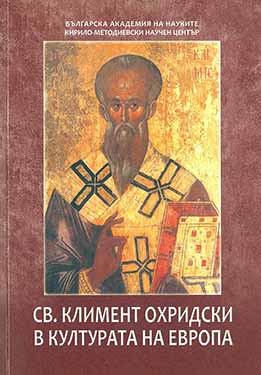Патриарх Фотий, Климент Охридски и славянското богослужение
Patriarch Photios, Clement of Ochrid and Slavonic Liturgy
Author(s): Liliana Simeonova
Subject(s): Language studies, Language and Literature Studies
Published by: Кирило-Методиевски научен център при Българска академия на науките
Summary/Abstract: The manifold endeavors, which brought into the Christian community peoples of diverse origin, go to the credit of Emperor Justinian (525–565). In the 860’s, after a lapse of three hundred years, Byzantium resumed its missionary activities abroad: the mission of Cyril and Methodius to Moravia and the conversion of Bulgaria to Christianity are characteristic examples. The contemporary Byzantine sources, however, make no reference whatsoever to the Moravian mission. It is the Slavonic sources – and, above all, the vitae of Cyril and Methodius – that provide evidence of the Moravian mission; briefly, it is also mentioned in some later Greek-language hagiographical works, which appear to be based on earlier Slavic texts. In this group of sources, the spread of Byzantine Christianity is strongly linked with the spread of literacy among the Slavs. As for Bulgaria’s conversion to Christianity, the Byzantine sources present either incomplete or semi-legendary accounts of it. None of the extant sources providing evidence for the Byzantine missionary activities either in Moravia or Bulgaria mention by name the then patriarch of Constantinople, Photios (858–867; 877–886): according to the Byzantine tradition, it was the emperor, and not the patriarch, who was entrusted with the apostolic missionary task of spreading Christianity among all nations. The present article deals with the introduction of the Slavonic language into liturgy, the role which St. Clement of Ochrid later played in the spread of the new faith and the Slavic literacy among the Bulgarians, and Patriarch Photios’ attitude toward the Slavonic liturgy. An understanding of these events requires a new interpretation of sources, which are controversial and problematic. Patriarch Photios seems to have had a negative attitude towards the use of Slavonic for liturgical purposes. The papal attitude towards the work of Cyril and Methodius was not straightforward; nor was the Roman approach to the use of the Slavonic liturgical language. An analysis of the broader historical context in the available sources suggests some interesting points, which may help clarify the issue of the use of the Slavonic liturgy as a tool for integrating the Slavs and, above all, the Bulgarians into Christian civilization while helping them preserve their own language as well as their ethnic identity.
Book: Свети Климент Охридски в културата на Европа
- Page Range: 364-377
- Page Count: 14
- Publication Year: 2018
- Language: Bulgarian
- Content File-PDF

